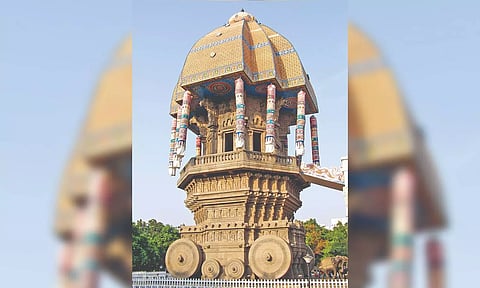

CHENNAI: Erikarai Mariamman (the goddess on the lake bund) is situated in Nungambakkam, surprisingly right in the middle of many different types of constructions that include stadiums and slum tenements.
In the busy road where people hustle and bustle through everyday traffic, no one wonders why this place was given such a name.
The largest lake in the city was the long tank stretching 5.5 miles long and 1.5 miles wide. This water body connected the two rivers of the urban fabric during the monsoons and kept the city free from waterlogging.
But in 1921, the Justice Party-run government decided the urban remnants of the British-designed Madras
Madras was not for individual bungalows and upscale housing. They looked around to build the city of the Indians and zeroed in on the lake.
What could have been converted into a big water reservoir or a flood abatement scheme, was mindlessly closed to create Thyagaraya Nagar. And whenever a need arose, a remaining part of the lake was filled to form colleges, schools, and housing.
There was one small bit of a few acres that remained in Nungambakkam. But it had become landlocked and ended up being a huge sewer pit. Buffaloes wallowed in it and mosquitoes bred in a fury. The then DMK government decided to close it and ironically built a monument to poet-saint Tiruvalluvar, who had advocated the maintenance of water bodies some 2,000 years ago.
A poet or a saint both Hinduism and Jainism lay claim to. As Madras and Madurai claim to be his birth place. His set of couplets are intact and make a lot of sense in the modern world too.
Madras, though challenged for the claim of his living place, has a great role to play in his rediscovery and popularity. A British collector of Madras, Whyte Ellis was a die-hard fan, and translated a part of the book and published it. He even minted a gold coin of the saint imagining him with a top knot hairdo and a long beard. After refinement, the picture is still used everywhere to symbolise the saint though the colour of his robe is changed to either white or saffron depending on who is promoting him.
Karunanidhi, who followed Anna as the DMK Chief Minister, was an ardent follower of Valluvar. He would write an explanatory text of each of the 1,330 couplets. MK wanted to build a monument for Valluvar and hailing from an atheistic movement did not want it to turn into a temple. (Valluvar in fact has a temple in Mylapore)
So Valluvar Kottam was planned as a secular structure in Nungambakkam.
Since the Kottam had to have an old world feel, a sthapathi (traditional architect) was chosen to execute the project. Vaidyanatha Ganapathy sthapathi planned a structure resembling a Hindu temple chariot . He modelled it on the largest of the temple chariots the Tiruvarur aazhi thaer, which has been mentioned in the ancient texts of Devaram and Silapathikaram. Karunanidhi’s hometown was very close to Tiruvarur.
The favourite temple of the Cholas, Tiruvarur had a mighty chariot. The 30-feet wooden structure would be decorated before the ceremonial pulling by devotees and would rise to a height of 96 feet. Weighing a mammoth 300 tons, a coir rope one foot in diameter would be used to pull the chariot around the temple.
The building of the Kottam was a challenging task. 3,000 granite stones had to be transported from a quarry in Tiruvannamalai to the busy Nungambakkam. The tonnage was 27,000 tons and the largest stone amongst them weighed 40 tons. As it was the Chief Minister's pet project, the traffic was diverted and giant lorries were seen moving the stones.
Each stone was carved with intricate sculpture bringing to mind the traditions of stonemasons of the past. The stone chariot was big and the wheels themselves stood eleven feet high. Valluvar’s statue was placed on the chariot.
2500 people worked on the statue day and night. There was a race against time and pressure from the Chief Minister's office to speed up the work. Most people thought it was only because of the eagerness of the CM to see his dream come true. But Karunanidhi knew the truth. He knew he would be unseated any moment. It was a love-hate relationship between the then DMK and the Congress. When political novice Indira rebelled against the seniors in her party she was pushed to a minority. DMK supported her and even helped pass some major bills in parliament.
But when India declared the emergency in 1975, she dismissed most of the non-Congress governments in the states. Karunanidhi was spared but his activities did not go well with the PM. Tamil Nadu became a haven of pro-democratic activists hiding from the police force. MK also held a meeting in Marina, where he made a quarter million strong audience take an oath that they will save democracy. Meanwhile, Indira’s patience was waning.
Valluvar Kottam was completed and invitations printed for its inauguration. The President was to fly down to open it. With seven days left for the function, Karunanidhi was dismissed. The function went on but Karunanidhi was not invited. However, when he came to power a few years later he wanted to be sworn in as Chief minister in Valluvar Kottam.
Today a few tourists visit Kottam daily, and many shopping events happen. The entrance is a preferred spot for protests now.